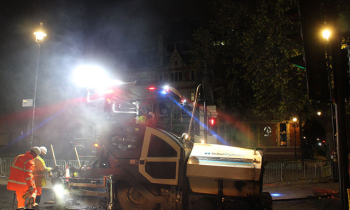Collaboration keeps traffic moving during Parliament Square resurfacing
Joint venture CVU (Colas, VolkerHighways, AECOM) recently appointed VolkerHighways’ surfacing team to deliver resurfacing works at Parliament Square, Westminster, on behalf of Transport for London.


Due to the extremely busy location, the team had to work closely with the client to manage road closures and minimise disruption. In addition, City of Westminster were undertaking separate works on nearby Bridge Street, so both teams were required to coordinate their road closures and signage, to ensure drivers were aware of both sites and diversion routes kept traffic flowing as smoothly as possible.
In order to ensure the roads could reopen as quickly as possible, the team used an innovative single layer asphalt, removing the need for a binder course, even though a depth of 70mm was being resurfaced. This decision meant the resurfacing was complete in just seven night shifts, as opposed to approx. 16 shifts required to lay traditional two-layer asphalt.
The team then used an additional five shifts to complete the replacement of the square’s existing ironwork, such as drain and manhole covers, with a new, longer-lasting reinforced solution.
The choice of materials and close collaboration with both Transport for London and City of Westminster meant the project was delivered to a high standard and completed in just 12 nights, with minimum disruption to the London bus network and the travelling public.
Vince Gannon, contracts manager for CVU, said: “This was a challenging and complex project to take on, with multiple parties working closely together to ensure a fast turnaround. Thanks to the collaborative efforts of everyone involved, we have been able to deliver a long-lasting, high quality finish for Parliament Square, with the minimum disruption to road users.”
Janish Patel, programme manager for TfL, said: “It’s been impressive how CVU have completed this resurfacing work so quickly, particularly as this location is one of the most challenging areas within London. The coordination of the work itself was well managed and involved working closely with bus operators, subcontractors and the City of Westminster."



